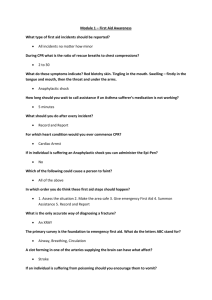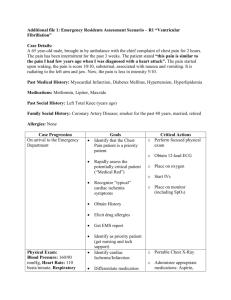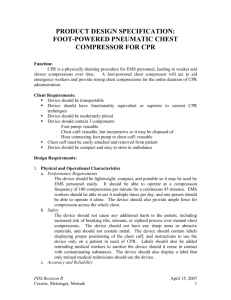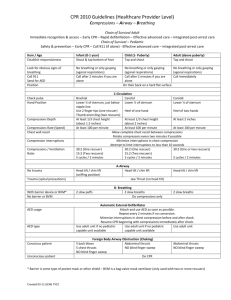Small Business Innovation Research File
advertisement
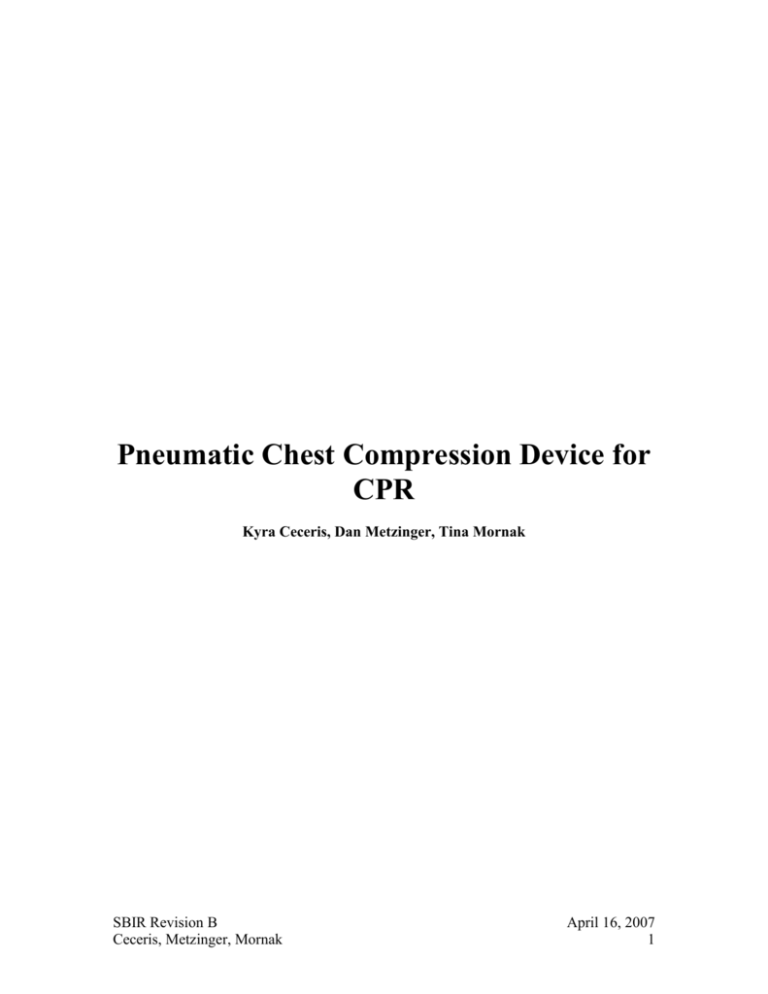
Pneumatic Chest Compression Device for CPR Kyra Ceceris, Dan Metzinger, Tina Mornak SBIR Revision B Ceceris, Metzinger, Mornak April 16, 2007 1 Introduction The goal of our research is to create a pneumatic chest compression device to deliver more effect chest compressions to patients while reducing the fatigue in emergency workers performing CPR. This device will provide chest compressions to a patient through the use of a foot pump. We propose to construct our device of three parts. The first part of this system is a chest cuff, implementing a “one size fits all” cuff that will fit the average sized adult male/female. The second part of this device is a spring loaded foot pump that will quickly inflate and deflate the chest cuff through the third part of our device, which is tubing connecting the foot pump to the chest cuff. All three of these parts will be reusable. The chest cuff will also contain Velcro, to ensure a quick and secure way to attach it on the patient. The Velcro will also allow for easy adjustments so it can fit many different sized patients. Our device will also be small and compact so that it can easily be stored on an ambulance shelf. This system should also be able to rapidly inflate and deflate. The chest cuff will need to inflate (and deflate) 100 times per minute to meet the minimal required amount of chest compressions as stated by the American Heart Association. In the long term, we hope that our device will have a higher success rate for CPR in comparison to manual CPR. Our device will provide more effective chest compressions and generate better hemodynamic characteristics than manual chest compressions by providing circumferential compressions to the patient. We would also hope that our device would not cause any additional harm to the patient, such as breaking ribs (which is common during conventional methods of CPR). We plan to test the device to support previous research that circumferential compressions are more effective than standard CPR methods.1 Specific Aims Specific Aim 1: Design of two pneumatic chest compression prototypes We will develop two prototype designs based on the needs stated above, while keeping in mind that the design must be portable, compact, and lightweight. The prototype designs will contain a chest cuff that will provide circumferential compressions to the patient. Specific Aim 2: Fabricate a sufficient number of devices for Phase I testing We propose to make our device out of plastic materials so that it is light in weight and, therefore, easily transportable. The plastic will help make the device water-proof so it can withstand all weather conditions. Since we would like our device to be reusable, the plastic material will be easy to sanitize. Initial prototypes will be stock parts that are modified to meet design goals stated in our PDS. Specific Aim 3: Conduct performance testing to adjudicate feasibility of the prototype device(s). Testing will include but not be limited to cyclic frequency testing, initial determination of bladder rupture, foot pump air displacement, and ease of use by end users. SBIR Revision B Ceceris, Metzinger, Mornak April 16, 2007 2 Background and Significance Out of the 460,000 Americans who get cardiac arrest each year, a small percentage of 5-15% of them survives, because attempts to resuscitate them are generally unsuccessful.2 Because conventional methods of CPR are often performed incorrectly, a device that will perform CPR may be a good solution to eliminate fatigue in the emergency workers, improve blood flow, and increase survival rates. There is a need for a device to aid emergency workers in providing reliable and effective chest compressions during CPR. Conventional methods for manual CPR often fail when CPR is performed for extended periods of time since emergency workers become physically exhausted.3 This often occurs when a patient isn’t located near a hospital, and it may take an ambulance 30 minutes (or longer) to reach a hospital. When manual CPR is performed for extended periods of time, such as in the situation previously described, multiple EMS workers are required to maintain an adequate quality and quantity of chest compressions, which becomes difficult as the workers become fatigued. As the workers become tired, chest compressions become slower and weaker over time, making conventional methods of CPR less effective over long periods of time. When one EMS worker becomes fatigued, another may need to take-over chest compressions, which depletes the resources available to perform life-saving procedures. More EMS workers are required on the scene to perform a task that could be done by one person with a chest compression device. If a device were created to alleviate these problems, successful CPR could be performed for greater lengths of time, while decreasing the mortality rate of patients who are required to receive CPR. Effective CPR may double the chance of a patient’s survival.2 A foot-powered chest compressor will act to reduce the energy output of emergency workers and provide stronger and more effective chest compressions to the patient for the entire duration of CPR administration. By using a large cuff that inflates and deflates on the chest, CPR can be administered by a safer and more effective means. With a device, chest compressions would be more consistent and without pauses, which can mean the difference between life and death for a patient. Pausing for too long can mean a stop in the blood flow to the heart and brain, which could kill the patient. A device that would reduce or eliminate pauses in compressions could only help in resuscitating the patient. Recent studies have shown that it may even be better to continue compressions without pausing to give breaths, which makes manual CPR even more tiring.4 The studies recommend new guidelines stressing continuous compressions for 4 minutes, followed by a rate of 100:2 compression-ventilation ratio. Since current AHA guidelines recommend a 30:2 compression-ventilation ratio,5 this challenges CPR administrators to effectively provide reliable compressions for longer periods of time. A CPR device would help give compressions of consistent force and depth, eliminating the problem of compressions becoming weaker over time as the EMS worker becomes tired. Almost one million heart attacks occur every year in both pre-hospital and hospital environments, where each case has the potential to progress into cardiac arrest in need of CPR.2 Therefore, our device will be incorporated into the ambulance setting, and eventually in the hospital setting. We would like our device to be readily available to medical workers in case of these emergency events. SBIR Revision B Ceceris, Metzinger, Mornak April 16, 2007 3 Currently, chest compression devices that are on the market are not widely used for various reasons. Some are heavy and are frequently left behind by emergency workers due to the amount of other equipment that is needed in an emergency. Since our device will be specifically designed to be small and lightweight, it will not be a burden to include our product with the other equipment that the workers carry in these situations. Some of the other devices already on the market also require long periods of time to setup. This is not practical since the emergency workers will be setting up the device instead of immediately providing CPR to the patient. Our device does not require any previous setup time until it reaches the patient. Once the device reaches the patient, the chest cuff can be easily placed on the patient within seconds. Other devices are battery operated, which requires them to be recharged every 30 minutes. This can be a downfall if CPR is required to be performed for longer than 30 minutes, and the device is not accessible to a power outlet. Our device is simply operated by the user and does not require a battery for use. It does not require any extensive set-up or preparation. These non-ideal qualities of previous devices give us the opportunity for great improvement and to create a device that will be widely used. In a previous study, a circumferential vest device used for CPR was shown to successfully increase aortic pressure and coronary perfusion. Spontaneous circulation returned in 8 out of 17 patients who used the CPR vest device in comparison with 3 out of 17 patients who received manual CPR. More patients who used the CPR vest, in comparison with patients who received manual CPR, were also shown to be alive for longer periods of time, although none of the patients survived due to pre-existing organ damage.6 Research Design and Methods Our device consists of two assemblies, a foot powered air pump and chest cuff. Tubing connects these two assemblies and is equally as important to function. Design and Manufacture of the Foot Powered Air Pump: A raft inflating pump was purchased from Sevlyor. The pump consists of two flat plastic pieces (a top and bottom) that connect in the front with a dowel pin. This pin allows articulation of the plastic pieces which are connected by a heavy-duty plastic sheath. When compressed, air is expelled via a one-way rubber value connected to the plastic top. After compression, a spring in between the plastic top and bottom forces the plastic pieces apart creating a vacuum which allows air to reenter the device from another one way rubber valve. For storage reasons the device can also be stored with a compressed spring to minimize storage size. This design works well when it is needed in an open system; however, in our case a closed loop system with a constant volume of air (approximately 2 liter) is needed. In order to change the pump from an open loop system to a closed loop system, one of the one-way valves was removed and small pieces of acrylic were placed in the outstanding hole preventing air from entering or exiting the foot pump via this route. By proper closure of one hole, air is pushed out of the foot pump from the remaining hole but is also drawn back in from the cuff through this hole. The nature of the closed loop design solves the problem of keeping the air volume inside SBIR Revision B Ceceris, Metzinger, Mornak April 16, 2007 4 our device constant, however, it also creates a problem in which air must rapidly enter and exit from only one hole in the foot pump leading to poor cyclic frequency of the device. The proposed redesign was the addition of another spring to the foot pump in the same position of the first spring. This additional spring increased cyclic frequency because re-inflation stage time after compression of the foot pump was decreased due to increased force articulating the two plastic pieces apart. Also, the acrylic pieces closing one hole in the top of the foot pump allowed for a closed loop system. Additional sealing was accomplished by placing a rubber gasket between the two acrylic pieces decreasing air leakage to negligible quantities. Design and Manufacture of an Inflatable Chest Cuff: Two blood pressure thigh cuffs made of nylon were purchased and connected together with the Velcro supplied. Once both cuffs were placed together, the total cuff was then long enough to fit around the circumference of a normal male or female torso. This cuff was then fitted with two water reservoirs with ¼’’ inside diameter tubing. These reservoirs comprise of a 3-ply polyethylene plastic for burst strength, puncture resistance, and abrasive resistance. These reservoirs fit inside the cuff and when properly inserted, inflate and compress the sides and front of the torso. Because of time constraints no additional modifications were made to stock parts for the cuff portion of the device. Design and Manufacture of the Plumbing Connecting Pump and Cuff: Initially blood pressure bladders were used to inflate within the nylon thigh cuffs. The rational was that they inflate and deflate to high pressures in upward of 250 mmHg. However, they are only available with standard 1/16’’ I.D. tubing for inflation and deflation. This small diameter greatly inhibits the cyclic frequency needed as well as the volume of air required to properly inflate the bladders. For this reason the smallest tubing used was ¼’’ I.D. tubing which then branches from each bladder to a ½’’ I.D. tube which then connects directly to the foot pump. Cyclic frequencies with this designed tubing diameter are not completely optimal however have a respectable frequency of approximately 57 cycles/min. Testing the Air Volume Displaced by the Foot Pump: A device was built to test the air volume displaced by the foot pump. An air tight bottle with a fitting to connect to the hose was manufactured. A glass rod was then inserted into the airtight bottle and glued a few centimeters from the bottom of the bottle. Once all parts were glued and allowed to dry, the foot pump hose was connected to the testing device and effluent tubing was attached to the glass rod. After filling with water, the pump was compressed and the amount of water displaced from the testing device from the effluent tube was measured. This amount of water displaced is equal to the amount of air the pump can displace. This was calculated to be 1798ml of total air displacement. Testing the Cyclic Frequency of the Device as a Whole: SBIR Revision B Ceceris, Metzinger, Mornak April 16, 2007 5 The chest cuff was placed on a standard CPR manikin and made as tight as possible. Each air bladder was approximately 4” away from the centerline of the manikin’s chest and these bladders covered an approximate 160° of chest circumference. Resting approximately 3 feet below the chest cuff and manikin was the foot pump on a carpet surface. The foot pump was depressed until the bladders completely filled with air and then the air was allowed to escape the bladders by aspiration accomplished by the double spring assembly in the foot pump. The number of repetitions this entire cycle was completed was counted during a 60 second time trial. The average of three trials was experimentally determined to be 56.67 cycles/min. No statistical analysis was preformed because of the small number of data points, n=3. Future Work: At this stage in development the device has a respectable cyclic frequency average of approximately one full compression and near full deflation per minute. Although the device falls slightly short of current suggested CPR frequencies, the device shows promise in the following areas. First, the small size and weight of the device surpass current devices on the market and those being tested. Second, the price of the device is significantly less than other devices with materials costing less than $55 and having a simpler design than predicate devices. Lastly, fatigue should be considerably less than conventional CPR because this device moves muscle work to larger muscles groups such and the quadriceps with the opportunity to switch legs in case of fatigue because of the device design. In the near future, further testing will determine the cuff’s applied force to the torso as well as the effectiveness of compressions. In addition, custom foot pump and cuff designs will be developed and alternative materials and tubing to connect the components to increase cyclic frequency will be considered. SBIR Revision B Ceceris, Metzinger, Mornak April 16, 2007 6 References 1. Halperin, H. R., et al. Cardiopulmonary resuscitation with a novel chest compression device in a porcine model of cardiac arrest: Improved hemodynamics and mechanisms. J Am Coll Cardiol 2004; 44: 2214-2220. 2. AHA CPR Facts and Statistics. http://www.americanheart.org/ 3. Abella BS, Sandbo N, et al. Chest compression rates during cardiopulmonary resuscitation are suboptimal: a prospective study during in-hospital cardiac arrest. Circulation. 2005; 111: 428–434. 4. Roppolo, L.P., et al. Modified cardiopulmonary resuscitation (CPR) instruction protocols for emergency medical dispatchers: rationale and recommendations. Resuscitation. 2005 May; 65(2):203-10. 5. 2005 American Heart Association Guidelines for CPR. http://circ.ahajournals.org/content/vol112/24_suppl/ 6. Halperin, H.R., et al. A Preliminary Study of Cardiopulmonary Resuscitation by Circumferential Compression of the Chest with Use of a Pneumatic Vest. New England Journal of Medicine. 1993; 329:762-768. SBIR Revision B Ceceris, Metzinger, Mornak April 16, 2007 7

